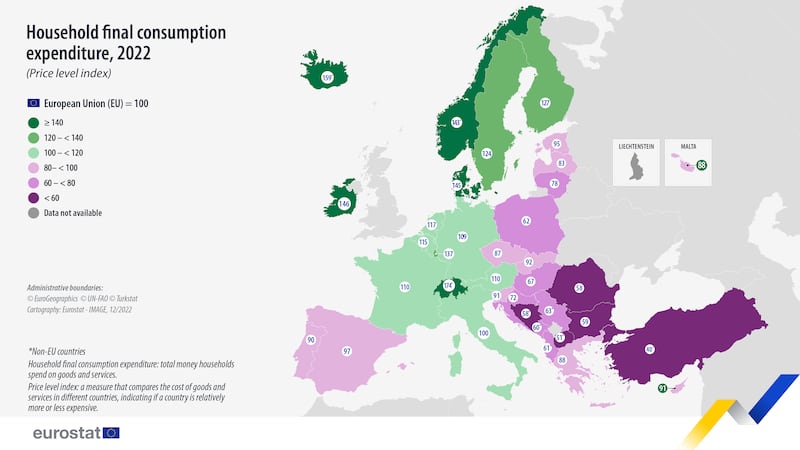Prices for consumer goods and services in Ireland were higher than anywhere else in the European Union (EU) last year, according to latest data published by Eurostat.
A survey comparing the prices of goods and services across 36 European countries in 2022 shows that prices in Ireland were 46 per cent above the EU average, and the highest of any EU member state.
Price level indices (PLI) for last year, published by Eurostat on Wednesday, are based on price surveys covering more than 2,000 consumer goods and services.
At 146 per cent of the EU average, prices in Ireland were higher than those seen in Denmark (145 per cent) and Luxembourg (137 per cent).
READ MORE

Ireland’s PIL of 146.4 last year increased from 143.8 in 2021, and is up from 121.9 a decade ago when Ireland’s consumer prices were cheaper than the UK, Luxembourg, Finland, Sweden, and Denmark.
Ireland’s ranking as the most expensive state in the EU in 2022 was even more pronounced when examining prices for alcohol and tobacco.
Prices in Ireland were more than double (216 per cent) the EU average, and were more than three times as high as the lowest prices recorded in Bulgaria (66 per cent of the EU average).
The large price variation is mainly due to differences in taxation of these products.
Other areas where Ireland was significantly above the EU average last year include for communications (such as postal and telephone services) which were 56.4 per cent above average, and energy prices, which were 38.4 per cent above average.
The only category of consumer goods that was cheaper than the EU average in Ireland last year was clothing, as consumers in Ireland paid 3.3 per cent below average.
May’s Consumer Price Index (CPI), released by the Central Statistics Office (CSO) earlier this month, reported annual inflation of 6.6 per cent, the twentieth straight month where the annual increase in the CPI was at least 5 per cent.
The Central Bank also warned this week that inflation would be higher than expected this year, averaging 5.3 per cent, and would moderate more slowly than previously anticipated in the coming years.















